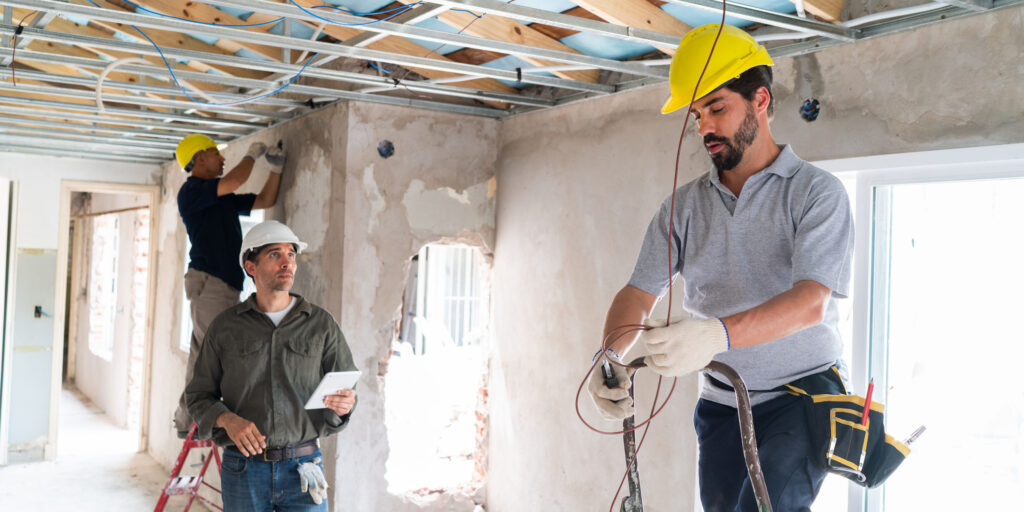— 7 min read
Why Communication is the Hidden Risk Factor in Construction
Last Updated Mar 31, 2025
Last Updated Mar 31, 2025

Construction is a high-risk industry—not just financially, but physically and reputationally. While significant effort goes into mitigating physical hazards, ensuring financial control, and protecting contractual interests, one of the biggest risk factors often goes overlooked: communication.
Miscommunication on-site can lead to costly mistakes, delays, and even dangerous situations. A lack of clarity in expectations, a failure to adapt communication styles, or the tendency to manage through authority rather than collaboration—all of these can fuel conflict. When conflict isn’t managed well, it can ripple across a project, eroding productivity, morale, and trust.
The best construction leaders understand that effective communication is not just about delivering instructions; it’s about fostering understanding. It’s about setting expectations early, reinforcing them through multiple methods, and, most importantly, maintaining respect under pressure. If we want to build stronger teams and more resilient projects, we need to rethink how we communicate.
Table of contents
Identifying the Root Causes of Conflict in Construction
Conflict on a construction site is inevitable—but it’s also predictable. Understanding its root causes allows leaders to address issues before they escalate, preventing costly disruptions.
Lack of Clarity
Unclear communication is one of the most common, yet underestimated, causes of conflict. Instructions that are vague, overloaded with technical jargon, or fail to accommodate different learning styles can lead to costly mistakes.
The best construction leaders don’t just issue directives; they ensure understanding. That means delivering key messages through multiple methods—verbal discussions, visual aids, and written documentation—to reinforce expectations and eliminate ambiguity.
Moving Away from ‘Command and Control’ Management
Pro Tip
If something goes wrong, call for a pause. Take a moment to assess the situation calmly, discuss what happened, and set a path forward—without assigning blame.
Crisis moments test leadership. The best leaders meet them with composure.
The days of managing by shouting orders and demanding compliance are over—or at least, they should be. While urgency is a reality in construction, leadership by intimidation is counterproductive.
Strong leaders recognise that dialogue fosters accountability better than dictation. Instead of reacting with frustration, asking questions like “What happened?” and “How can we get back on track?” creates a culture where people feel responsible for solutions, rather than fearful of mistakes.
Misaligned Expectations
Another trigger for conflict may be a mismatch between the safety expectations and practices the project manager is stipulating, and the habitual ones the subcontractor is familiar with. Methodologies also, if they vary from a subcontractor’s usual approach, can be a point of contention.
One example comes to mind: A site manager, frustrated with an incorrectly installed gyprock panel, smashed a hammer through it. While his frustration was understandable, his method of “communication” achieved nothing. The issue wasn’t just the mistake—it was the lack of clear guidance beforehand.
Setting expectations early—both in writing and through demonstration—is critical. This is especially true for less experienced workers, who may not yet have the instinct to double-check their work. Clarity up front reduces rework, improves quality, and minimises conflict before it starts.
Practical Steps for Reducing Conflict Risk
Pro Tip
Show, don’t just tell. Demonstrate exactly what’s expected, using drawings and written documentation to reinforce methods and quality standards.
Ensuring all expectations including methods, safety, quality and process are communicated in the earliest stages, through multiple means including both written and visual, can lay solid groundwork.
By ensuring that expectations around methods, safety, quality, and processes are clearly communicated from the start—through both written and visual formats—you lay the foundation for smoother project execution.
Equally important is maintaining composure when things don’t go to plan. And let’s be honest—on a construction site, the unexpected is the norm, not the exception.
It's not necessarily telling someone their job, but telling them how you want it done, because there can be more than one way to do something.
Michelle Stack
Senior Strategic Product Consultant
Procore
Managing the Pressure of Tight Deadlines
Tight deadlines are an ever-present reality in construction. When pressure mounts and time is running out, there’s often a temptation to bark orders rather than negotiate solutions. This can lead to raised voices, heightened tensions, and unnecessary conflict. Everyone being aware of the plan as early as possible should reduce a lot of conflicts. Proactive communication—ensuring that every team member
Maintaining Respect Under Pressure
No matter the circumstances, staying calm is non-negotiable—especially for those in leadership roles. When site managers maintain composure, it sets the tone for the entire team.
This isn’t just about good behaviour; it’s about creating a job site culture that fosters collaboration, supports mental health, and keeps the project running smoothly.
There are some amazing site managers out there that are really setting the culture of a job site. And if they stay calm, then everybody else stays calm. If they start shouting, then it's mayhem. Everybody's shouting at everybody, and it's ugly as hell.
Michelle Stack
Senior Strategic Product Consultant
Procore
Identifying the True Cause of Problems
Root cause analysis is a valuable tool. This means looking not only at what has gone wrong, but also what was the cause of it going wrong. Then coming up with a way to address the cause, which will both mitigate the current problem and reduce the risk of it occurring again.
For example, if a bricklaying subcontractor is frustrated because materials didn’t arrive on time, the issue might not be the delay itself, but rather:
- A breakdown in communication between the supplier, delivery driver, and site team.
- A failure to plan alternative productive tasks for the crew while they waited.
Identifying the true cause of the issue doesn’t just resolve the immediate frustration—it improves coordination for future projects.
The top person in a team has to conduct themselves in the way that you'd expect everybody to conduct themselves.
Pro Tip
Despite the best planning, conflicts will still arise. The key is to de-escalate them quickly and constructively.
- Stay calm. Your tone and body language influence how others react.
- Separate the issue from the individual. Address the situation, not the person.
- Acknowledge the problem. Simply recognising the issue can prevent further frustration.
- Shift the focus to solutions. Encourage collaboration on the path forward.
We all need to collaborate better and have some skills around that. Part of that is talking to the situation, not about the person
Communicating in a Crisis
Beyond the kind of issues that can arise on site, sometimes a genuine crisis occurs. That may be due to an external event such as a natural disaster, a financial event such as a key subcontractor or the main contractor becoming insolvent, or a major safety incident such as a scaffolding collapse.
For any major project, a crisis communications plan developed in partnership with head office management at the outset of the project is valuable. It's important to know all of the people that need to be communicated with and having a plan setup that will include:
- Clear triggers for when the plan is activated
- Defined roles for internal and external communication
- After-hours contact lists for key decision-makers
- Holding statements (e.g., “We are still determining next steps”) to ensure consistent messaging
- Protocols for serious incidents, including compassionate and transparent communication.
Building a culture of constructive communication drives project outcomes.
Conflict in construction is inevitable, but how it’s handled defines the success of a project and the relationships within it. Clear expectations, proactive communication, and a commitment to respect—especially under pressure—can prevent many disputes from escalating.
At its core, effective conflict management isn’t about avoiding disagreements but navigating them in a way that strengthens collaboration rather than eroding it. Whether it’s a misunderstanding about scope, a disagreement over methodologies, or a high-pressure deadline, the solution remains the same: communicate early, communicate clearly, and communicate with respect.
The best-managed projects aren’t the ones without challenges—they’re the ones where challenges are met with clarity, composure, and collaboration.
Categories:
Tags:
Written by
Michelle Stack
10 articles
Michelle Stack is a Senior Strategic Product Consultant at Procore, bringing over 20 years of experience in project management, IT solutions, and change transformation. For 7 years, she has led technology change in the construction industry working closely with teams in design and construction through to post completion. Throughout her career, Michelle has successfully aligned operations with organisational strategies, ensuring changes are implemented through clear communication, training, and evaluation. Her extensive expertise has made her a trusted leader in driving effective, sustainable transformations.
View profileExplore more helpful resources

Construction Document Management: The Challenges and Benefits of Embracing a DMS
Every construction project begins, continues, and ends with a mountain of paperwork. From initial bidding documents to contractor agreements, blueprints, variation orders, inspection reports, on and on it goes. And...

Cash Flow Forecasting in Construction: How to Stay Ahead of Funding Gaps and Protect Project Performance
Cash shortfalls are a leading cause of stalled projects, unpaid contractors, and budget blowouts in construction. Without a clear forecast of how cash will flow in and out over time,...

Construction Handover: The Keys to a Smooth and Successful Transition
Project handover should be a seamless transition, but its success is determined long before the last walkthrough. When teams consistently align on design, timelines, and quality, and support that alignment...

Cutting Delays and Costs: Proven Ways to Boost Construction Site Efficiency
On-site efficiency separates profitable construction projects from those plagued by delays and budget overruns. In Australia’s construction landscape—where supply chain disruptions, skilled labour shortages, and increasingly strict regulations are the...